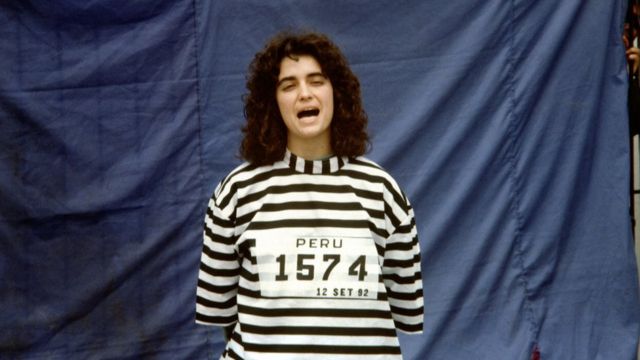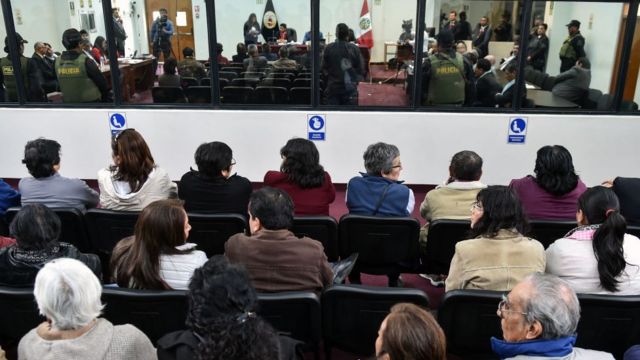September 11, 2021, 15:21 GMTupdated 1 hour
Abimael Guzmán, the founder and leader of the Peruvian guerrilla group Sendero Luminoso, died this Saturday at the age of 86 in the maximum security prison where he has served a life sentence since 1992.
This was reported by the detention center itself in a statement made public by the National Penitentiary Institute of Peru (INPE) on its Twitter account.
Guzmán passed away at 6:40 a.m. local time due to “Complications in your state of health”, according to the Technical Committee of the Maximum Security Detention Center (CEREC) of the Callao Naval Base.
His health had begun to deteriorate on July 13 and on July 20 he received geriatric care at a health center, INPE chief Susana Silva told RPP Noticias.
Guzmán became Peru’s most wanted man in the 1980s and 1990s.
The war between the guerrillas who led, Shining Path, a group of Marxist-Leninist-Maoist inspiration, and the Peruvian State left nearly 69,000 dead and disappeared in those two decades, according to the Truth and Reconciliation Commission (CVR) of Peru.
The most wanted man
The death of Abimael Guzmán occurred one day before the 29th anniversary of his capture, on September 12, 1992 in a house in the Surquillo neighborhood of Lima, by a special intelligence group.
Your image caged and wearing a black and white striped suit two weeks later it went around the world.
He was born on December 3, 1934 in the province of Islay, Arequipa, where he was raised by a wealthy merchant after the death of his mother.
TI had a privileged education. He attended a private Catholic high school and then the University of Arequipa, where one of his dissertations was on the German philosopher Immanuel Kant.
While in college he became interested in Marxism. By 1962 he had earned a place as a philosophy professor at the San Cristóbal de Huamanga National University in the central city of Ayacucho.
During a trip to China in 1965, Guzmán was inspired by the communist leader Mao Zedong and, upon his return to Peru, he encouraged like-minded academics to join him at the university of Ayacucho.
In 1969, he and 11 others founded Shining Path. The name was chosen as a nod to the Peruvian communist José Carlos Mariátegui, who said that “Marxism-Leninism is the bright path of the future.”

Inspired by Maoism, the guerrilla group attempted to lead a “people’s war” to overthrow the “bourgeois democracy” ofPeru and establish a communist state.
The group did not get involved in armed struggle at first, but was a branch of the Communist Party of Peru.
In 1978, Guzmán created the Sendero Luminoso Standing Committee, which would lead the group, and in which Guzmán ranked first.
The start of the bloody conflict
The turning point came in 1980 when the military, who had ruled Peru for 12 years, allowed democratic elections to be held.
Shining Path not only boycotted the elections, but actively disrupted them by burning ballot boxes in Ayacucho. The objective of the guerrilla group was to establish a communist state and, therefore, it was not interested in the democratic process.
Instead, it took over rural areas and sowed fear through public executions, followed by years of bombings and car bombs.
The government’s reaction
The government reacted with a state of emergency in the highlands and armed local militias known as “rondas” to fight back.
The atrocities committed by the military in their fight against the rebels led some people, especially in rural areas, to side with the Shining Path.
But the group’s brutal application of its own rules undermined the many supporters of those who would initially sympathize with the group’s goals.
One of the deadliest incidents occurred in 1983, when 69 locals were killed with axes, machetes and pistols in the Santiago de Lucanamarca area in retaliation for the death of a Shining Path commander.
But these acts were not limited to rural areas.
In 1992, two truck bombs detonated by the Shining Path in the Miraflores district of Lima, left 25 dead and 155 injured.
The capture of Guzmán
Authorities had long suspected that the rebels were hiding in apartments in Lima and were particularly suspicious of one that was owned by the dancer Maritza Garrido Lecca.

Although she claimed that she lived alone, the apartment generated too much garbage for one person.
When the agents searched it, They found drugs to treat psoriasis, a skin condition Guzmán was known to suffer from.
Officers arrested Guzmán inside, along with his second wife, Elena Iparraguirre, and several other members of the group. He was reportedly watching boxing on television when he was arrested.

After three days of trial, judges who wore hoods to hide their identities sentenced Guzmán to life in prison.
He was sent to an offshore naval base on the island of San Lorenzo.
However, the Constitutional Court (TC) annulled the sentence and ordered a new civil trial. Finally, in 2006 the Judicial Power sentenced him to the same penalty for the crime of “terrorism against the State”.
eltiempolatino.com